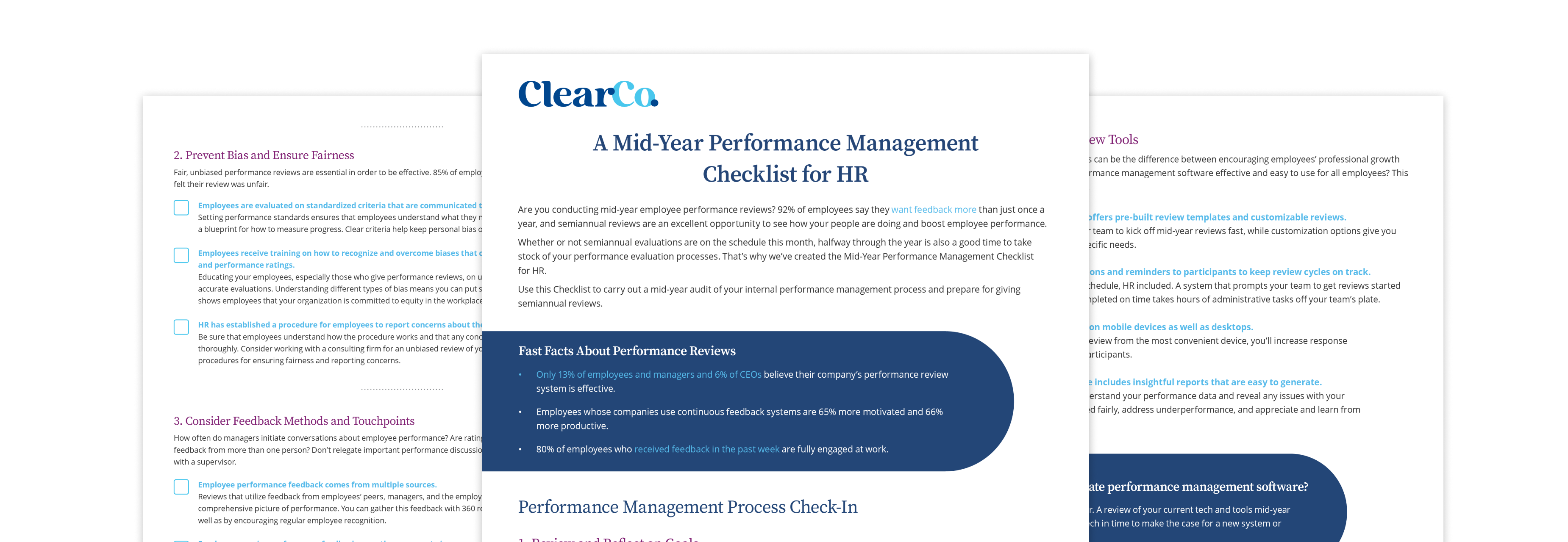Performance management is all too often a superficial, once-annual process that doesn’t contribute to actual performance improvement. If that’s the case at your organization, you’re missing out on the benefits of a strategic approach. Those benefits include real productivity increases, higher-quality output, increased employee engagement, and top-notch business outcomes. But you can’t get those results with a cursory annual review.
The most effective performance management processes are defined by structure, clear expectations, and continuous feedback. If you’re struggling to create a strategy that works, you’re in the right place. We’re unpacking everything you need to know about performance management, from understanding its importance to breaking down the key components of an effective process.
With the right approach, you can transform your workplace into a high-performing, feedback-driven environment where everyone thrives.
What Is Performance Management?
Performance management is a company’s process for setting goals, evaluating performance, giving feedback, and recognizing and rewarding employees. It’s how they ensure employees’ work is contributing to company goals and moving the business forward. At its core, performance management is about creating a culture of continuous improvement and growth.
Performance management activities include:
- SMART goal-setting for teams and individuals to align with company objectives
- Regular formal performance reviews, whether annual, semiannual, or quarterly
- One-on-one meetings with managers to track progress and provide support — weekly check-ins are often the most effective
- Career development opportunities and clear career pathing to keep employees engaged
- Spotting areas for improvement and honing individual strengths
- Identifying and closing skills gaps to future-proof your workforce
- Succession planning to prepare for leadership transitions
- Employee rewards and recognition to celebrate wins and boost morale
Of course, this isn’t an exhaustive list. Performance management is a flexible strategy that can encompass anything your business does to monitor, support, and improve performance. As HR leaders, you and your team members are responsible for tailoring it to your organization’s unique needs.
Traditional Performance Management Falls Short
We’ve all heard the gloomy statistics about traditional methods of managing employee performance. Whether you’re the employee being evaluated, the manager giving feedback, or the HR team handling review cycles and completion reminders, everyone is disenchanted with vague, sporadic, and inconsistent processes.
The data speaks for itself:
- More than 50% of employees said their expectations at work are not clear.
- Just 22% of employees said their company’s review process was fair and transparent.
- Only 2% of CHROs said their performance management strategy is working.
Clearly, the old approach isn’t just outdated — it’s not working, and it’s frustrating for everyone involved. Traditional methods leave employees questioning what’s expected of them, managers struggling to deliver meaningful feedback, and HR teams drowning in administrative tasks instead of driving impact.
Trade half-hearted annual reviews and unclear objectives for a dynamic performance management system. Put clarity, growth, and continuous improvement at the forefront with modern performance management.
5 Reasons Performance Management Is Essential
A great performance management strategy has so many benefits, the least of which include a standardized review process and ensuring employees get the recognition they’ve earned — and those are some significant advantages. Take a look at five of the top reasons it’s time to modernize your strategies.
1. Aligns Employees’ Work With Company Objectives
When employees understand how their work contributes to larger company goals, it’s an “Aha!” moment that’s motivating for many, especially top performers. It gives every task a sense of purpose and direction.
Your performance management systems foster this alignment by creating a clear roadmap for success. Working together on SMART goals that break down big objectives into everyday actions helps build a shared sense of purpose and strengthens connections between colleagues and teams. It also ensures everyone is rowing in the same direction.
2. Fosters Employee Engagement
Engagement is the difference between a team that just shows up and one that shows up ready to perform, and that’s where a strong performance management strategy makes a difference. While many outdated systems miss the mark — only one in five employees say performance appraisals actually inspire them to do better — that doesn’t have to be the case. But your strategy can do the exact opposite when you listen to what employees want.
With clear expectations, consistent feedback, recognition for their work, and effective performance reviews, companies can nurture engagement and get employees invested in their work. And the numbers back it up. According to McKinsey, 77% of employees who received ongoing feedback during development conversations felt motivated by their company’s approach to performance management, compared to just 20% without it.
Your performance management framework amplifies this connection with initiatives like weekly one-on-ones, recognition programs, and opportunities for growth through learning and development. By meeting employees where they are and supporting their success, you create a workplace where thriving becomes the norm.
3. Drives Continuous Growth and Learning
Employee training and development used to be infrequent after onboarding — nonexistent, in many cases. But we’re facing a staggering skills gap and labor shortages that demand companies invest in employee skill development. Not to mention, employers who offer growth opportunities see higher retention and are highly sought-after by job seekers.
A great performance management strategy identifies opportunities for growth at every stage of an employee’s career. By identifying the skills your company needs to keep growing and designing tailored development plans, you can upskill your workforce and future-proof your talent. You’ll also appeal to driven high-performers, both internally and externally.
4. Helps Retain Top Talent
Like we mentioned, your performance management strategy has a big impact on retention. Nothing sends top talent running faster than unclear expectations and stagnant roles. And when employees quit, there’s a ripple effect on productivity and workflow until the role is filled again.
A strong performance management strategy combats this by helping employees see a future for themselves at your company. Regular feedback, career development plans, and authentic recognition create a company culture that people don’t want to leave behind.
5. Enhances Business Performance
Your employees are what drives your business forward, so helping them improve should be imperative. When each employee performs better, teams perform better, and the company naturally follows. Effective performance management ties each person’s efforts directly to outcomes, creating a culture of accountability and shared purpose that drives measurable results.
5 Key Components of a Performance Management Cycle
Kinetic Construction upgraded its performance management processes with ClearCompany’s tools and templates. Read their success story.
To get performance management planning right, you need a strong foundation. These essential elements create a structured, repeatable framework that keeps your team aligned, engaged, and motivated.
1. Setting Goals
Success is difficult to achieve when you don’t know what “success” means. Using SMART goals to define expectations ensures that employees know exactly what results they’re targeting, whether the objectives are quarterly or annual. They also help managers evaluate progress objectively and give more useful feedback.
2. Providing Ongoing Feedback
We often talk about how consistent communication is the difference between a workforce that’s inspired and engaged and one that’s just going through the motions. Ongoing feedback provides opportunities to address challenges early, celebrate wins as they happen, and prevent employees from feeling lost at sea. Weekly one-on-ones are often the sweet spot, striking a balance between too much and too little interaction, but it’s important to foster a culture where employees feel they can always ask for feedback.
3. Evaluating Performance
Evaluations don’t have to be tedious or anxiety-inducing — in fact, when done well, they’re an opportunity for growth. The key is a performance review process defined by fairness and clarity. You need a system that uses real metrics, goal achievement, and peer and manager feedback. Many companies even include self-assessments to ensure employees’ voices are heard.
With performance management software, it’s easy to create a scalable, consistent process and create a well-rounded picture of performance. A software solution centralizes review creation and distribution, automates the most time-consuming parts of managing review cycles, and aggregates all the performance data you need in one platform. You’ll save time for your HR team and gain an in-depth, nuanced understanding of performance across your organization.
4. Recognizing Achievements
No one wants their hard work to go unnoticed. Regularly acknowledging employees’ contributions, big or small, reinforces positive performance and keeps morale sky-high. Organizations with recognition programs have 31% lower voluntary turnover.
From simple thank-yous to company-wide shoutouts, recognition fits into any workplace culture. If you’re using performance management software, employees can give their peers shout-outs, which can be posted to a team Slack channel and will show up on their next review. With baked-in compensation management tools, leaders are even able to tie rewards directly to performance achievements.
5. Supporting Learning & Development
This is where performance management becomes truly impactful. Encouraging growth through mentorship programs, professional development opportunities, and thoughtful career planning keeps team members engaged and ready for what’s next. It’s a win for both your company and your people.
Close the Gap Between Potential & Performance With Software
Performance management is more than setting goals and giving reviews. It’s a dynamic strategy that fuels growth and aligns individual efforts with company goals. When you focus on clear objectives, continuous feedback, and meaningful recognition, you can transform your workplace into a thriving, engaged, and high-performing ecosystem.
It’s time to leave outdated, uninspiring systems behind and invest in a modern approach that works for everyone. Is your strategy in need of a refresh? Find out with ClearCompany’s Mid-Year Performance Checklist for HR.

.png)
